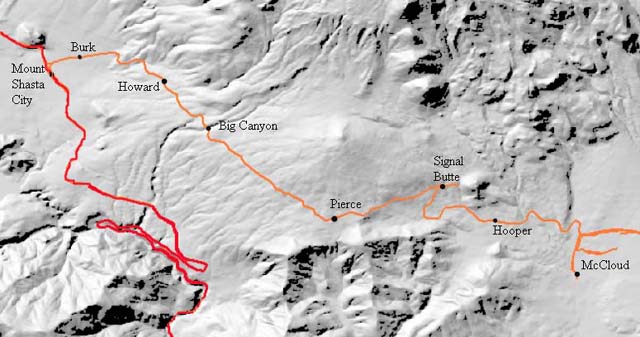|
McCloud Rails : Along the Line
McCloud-Mt. Shasta City |
|
|
|
|

|
|
McCloud is at Milepost (M.P.) 0. McCloud) is the operational center of the McCloud Railway Company. McCloud came into existence in 1897 as Vandale, created on the site of a former small sawmill camp. The site was chosen as the new location of the large sawmill to be built by the Siskiyou Lumber & Mercantile Company. The McCloud River Lumber Company came into existence in late 1896/early 1897, and everything in McCloud was put into that company. The McCloud River Railroad Company was completed into the town in July of 1897, and regular service began on 1 August of that year. The railroad built a large switching yard in McCloud as well as a roundhouse and a complete shop facility. A second yard, known as the run-around, is located approximately one mile east of the main McCloud yard. The huge McCloud River Lumber Company sawmill was built immediately to the east of the railroad facilities. McCloud was a classic company town from 1897 until 1963, when the McCloud River Lumber Company was taken over by U.S. Plywood Company. The McCloud River Lumber Company had a reputation for being especially good to it’s employees, and the company was affectionately known as “Mother McCloud”. A lot of tears were shed to mark the passing of Mother McCloud. U.S. Plywood kept the sawmill and railroad but quickly disposed of the company town. The sawmill stayed open until 1979, when it closed. P&M Cedar Products purchased and re-opened a portion of the mill complex, primarily to produce pencil stock. The mill eventually fell under the ownership of California Cedar Products, but unfortunately the decline in the use of wooden pencils spelled the end to the sawmill, as it shut it’s doors on Friday 30 May 2003. The sawmill is available for sale, but no buyers have yet come forward. The town’s character has changed considerably, from a company-owned timber town to a community dependant more on tourism than anything else. Hooper at M.P. M-3 is the location of a former water tank. The platform still stands, but the tank was pulled down in 2002. Signal Butte at M.P. M-5.1 is the location of one of the last switchbacks left on any railroad in the United States. Trains gain elevation by reversing direction here. The switchback tail track is 2861 feet long. Pierce at M.P. M-7.2 is the summit between McCloud and Mt. Shasta City. A double ended siding 1717’ long is located here. Pierce is used to re-assemble trains that have to be doubled over the hill due to tonnage or the length of the switchback. Big Canyon at M.P. M-11 was originally by-passed by another switchback. A large fill was constructed in 1902, eliminating the switchback. The fill stood until New Years Day in 1996, when massive flooding washed out the fill. The fill was re-built. Howard at M.P. M-12.5 was the home base of a section crew for many years. A large water tank was also located here to feed steam locomotives. The water tank stood into the 1980’s before it was torn down. The railroad sold the land to a homebuilder a number of years ago, and a fine house now stands at the site. The homebuilder uses a couple of the old section sheds, and a concrete pad marks the spot of the former water tower. Burk near M.P. M-14 once originated carloads of logs, but the station was abandoned a long time ago and the site is difficult to find today. Mount Shasta City was reached through a line change in 1907. It replaced Upton as the interchange point between the McCloud and the Southern Pacific. |
|
|
|
|
|
|
|